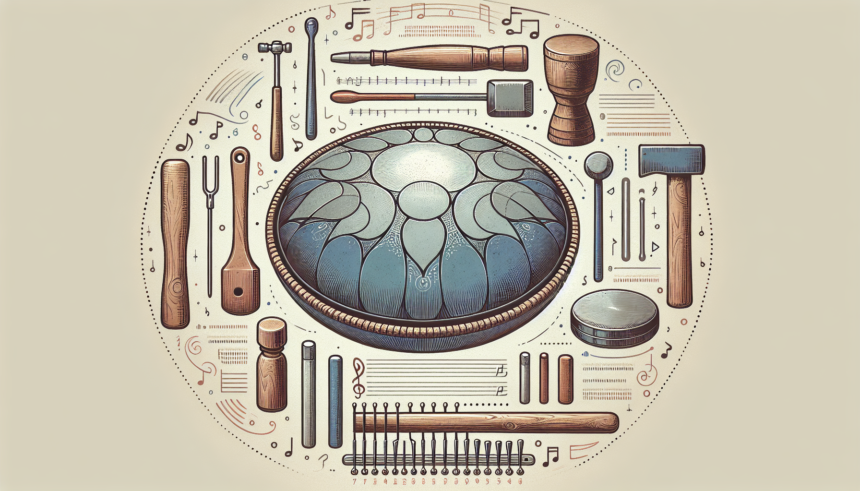Understanding the Handpan: A Brief Introduction
The handpan, a relatively new musical instrument, has taken the world by storm. Characterized by its ethereal sounds and unique, UFO-like shape, it offers an immersive musical experience. Because of its handcrafted nature and tuning complexities, maintaining and tuning a handpan requires specialized knowledge. This guide aims to provide all the information you need for handpan tuning and preservation.
The Significance of Proper Tuning
As with any musical instrument, proper tuning is crucial to ensure the handpan produces the best possible sound. Unlike many other instruments, the precision involved in tuning a handpan is on a highly delicate level. A well-tuned handpan resonates harmoniously, delivering a captivating sonic experience. Conversely, a poorly tuned handpan can disrupt the musical atmosphere, diminishing its mesmerizing quality.
Steps to Tune a Handpan
Tuning a handpan requires a combination of science, skill, and artistry. Below are the essential steps to properly tune a handpan:
- Understand the Basics: Familiarize yourself with the structure of the handpan and the placement of its note fields.
- Gather Your Tools: You’ll need tuning hammers, a strobe tuner, and your handpan. The strobe tuner is particularly important for achieving the necessary precision.
- Check Current Tuning: Use the strobe tuner to assess the current state of the handpan’s tuning. This helps you identify which notes need adjustment.
- Strike Gently: Use tuning hammers lightly to adjust the note fields. You’re not reshaping metal; you’re performing delicate tweaks.
- Test As You Go: Continually test the sound as you make adjustments to ensure the notes are tuning correctly.
- Be Patient: Tuning takes time. Rushing the process can lead to mistakes, potentially damaging the instrument.
Always remember, if you’re unsure about tuning your handpan, it’s best to consult a professional to avoid causing any damage.
The Art of Handpan Preservation
Maintaining your handpan is just as important as tuning it. Here are some key practices to ensure your handpan remains in optimal condition:
Regular Cleaning
- Microfiber Cloth: Regularly wipe down your handpan using a microfiber cloth to remove fingerprints and dust. This prevents oils from your hands from corroding the surface.
- Use Approved Cleaners: Only use cleaning solutions specifically designed for handpans. Avoid harsh chemicals that can damage the metal.
Proper Storage
- Safe Environment: Store your handpan in a stable environment with controlled temperature and humidity. Excessive moisture can cause rusting.
- Protective Case: Keep your handpan in a padded, hard-shell case when not in use. This shields it from physical damage.
Avoiding Damage
- Mindful Playing: Play your handpan gently to avoid denting or bending the metal.
- Transport with Care: Always handle your handpan gently when moving it. Ensure it is securely fastened if you’re transporting it over long distances.
The Role of Regular Maintenance
Even with regular care, your handpan will benefit from professional check-ups. These experts can perform detailed assessments and fine-tune your instrument, ensuring its longevity. Regular maintenance includes:
- Re-tuning: Over time, the notes on a handpan can drift. A professional re-tune ensures it remains in perfect harmony.
- Rust Prevention: Professionals can apply rust-preventative treatments to keep your handpan pristine.
- Structural Assessment: Check for any signs of wear or potential damage that could affect sound quality.
Conclusion
Owning a handpan is a unique and rewarding experience. However, as with any fine instrument, it requires careful attention to detail in both tuning and maintenance. By understanding the nuances of handpan tuning and committing to regular care, you can preserve the beautiful, resonant sound of your handpan for years to come. Whether you choose to tune your handpan yourself or opt for professional services, the effort you invest will surely be reflected in the music you create.
FAQs
1. How often should I tune my handpan?
The frequency of tuning depends on your playing style and how often you use the instrument. Generally, a handpan should be checked and possibly tuned every 6 to 12 months.
2. Can I tune my handpan myself?
While it is possible to tune your handpan yourself, it requires precision and experience. If you’re a beginner, it is advisable to seek the help of a professional to avoid accidental damage.
3. What should I do if my handpan gets rusty?
If you notice rust spots, it’s crucial to address them immediately. Use a mild steel wool pad to gently remove the rust, following up with a rust-preventative treatment. Consult a professional if the rust is extensive.
4. Are there specific cleaning products I should use?
Yes, always use cleaning products that are specifically designed for handpans. Avoid harsh chemicals or abrasive materials that can damage the surface of the instrument.
5. How can I prevent my handpan from getting damaged during travel?
When traveling with your handpan, use a sturdy, padded case. Ensure the handpan is securely placed within the case to avoid movement and potential impact during transit.





